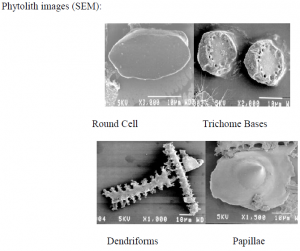Robert Ehlers and Dr. Terry Ball, Religious Education
Abstract
Phytoliths are silica deposits in plants that remain long-term in the soil after a plant dies. Phytoliths have unique characteristics that can be used to identify the phytolith’s original species. Phytolith morphometrics is a tool in archaeobotany that is used to identify ancient environments and landscapes. This study set out to discover if domestication of plants change phytolith morhpometrics. With identification of a probable effect of domestication on phytolith morphometrics, scientists can better identify periods of time when a plant species was domesticated. The research results can be a unique tool in identifying moments in history when a civilization began domesticating plants. Such knowledge is important in understanding ancient civilizations.
Project
Four morphological distinct phytoliths were measured in 11 varieties of wheat. The four phytolith morphotypes are round silica cell phytoliths, trichome bases, dendriforms, and papillae form phytoliths (see images below). Fifty of each of the four morphological types were sampled in each of the eleven varieties. The phytoliths are extracted from plant tissue, placed on slides for microscope use, and then the recorded images from the microscope are analyzed using computer programs.
Results
Statistically significant data was found between wild-type rondel cells and domesticated type rondel cells. The data suggests that rondel cells actually increase in size after domestication. No significant data was found in the other phytolith morphometric types (dendriforml, papillae, trichome base). Domesticated and wild type wheats can be distinguished by phytolith analysis. The data has the potential to become a powerful research tool for investigators working in a wide variety of disciplines that utilize phytolith analysis. These results have led us to extend the project to include domestic and wild-type barley. The data will be more conclusive after the complete analysis of the barley samples. Both the barley and wheat data will be compiled into one publication and it will have stronger results with both samples. The barley data is near completion and is showing similar results as the wheat data.
Working with my research mentor has helped me see what research is all about and how the process works. I learned about continuing to ask the “why” of research. The project has also helped me become aware of the research process. The concepts I have learned from research have helped me be a better student outside of the lab.

